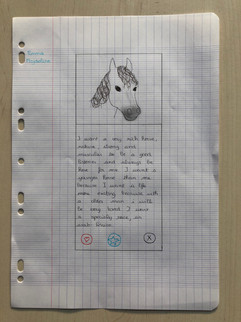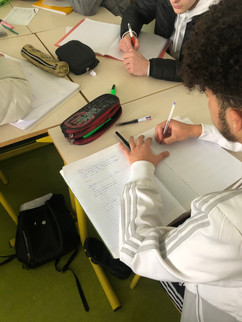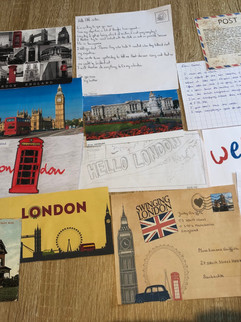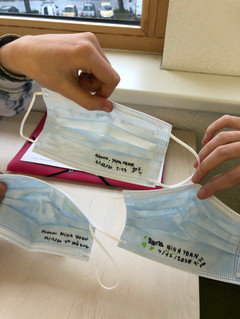Teaching English in France with TAPIF? Here Are Some Lesson Plan Ideas
- Aine Dougherty

- Nov 11, 2021
- 6 min read
Updated: Nov 16, 2021

Planning lessons can be daunting, especially when you're thrust in front of a class of blasé French high schoolers with little to no experience teaching and just one day of academy-wide orientation to guide you.

I came into the TAPIF program with plenty of individual tutoring under my belt, but I had never really planned a lesson or taught in front of a whole class before. I'm slightly ashamed to admit it, but I spent far too many stressful hours pulling something together last-minute, wishing that it was better. But after two years as a Fulbright and TAPIF English Teaching Assistant and several months as a lectrice at a French university, I can safely say that I've accumulated an arsenal of foolproof lessons that have worked for me.
With TAPIF, teachers can use you in many different ways in their classrooms, from taking small groups by yourself or co-teaching lessons in front of 30 pairs of eyes (and masks). They might ask you to prepare lessons that follow their curriculum, or they could give you complete artistic liberty. The experience is different for everyone, and each TAPIFer will have their own unique challenges and projects throughout the experience, but I'd argue that everyone should be prepared with some tried-and-true methods that work across a variety of different subjects.
I'm here to help you with that! Keep reading to discover my top three favorite lesson structures and several examples for each. You'll find a Google Drive link to my PowerPoints at the end!
1. Games

But you already knew this would be first. I taught at the secondary level, so in a French high school in Alsace, and one of the best ways to motivate my students was by adding in a competitive, dynamic element. Not just a good way to fill time, games also have real pedagogical value, as they can help get the entire class engaged and participating. They can also help students encode information and express their creativity better than a lecture, where they are likely to zone out the second they don't understand. Finally, they can also be used to grab your students' attention at the beginning of a lesson, or test their knowledge and up their energy at the end of one, depending on your needs.
Bref, games come in many shapes and sizes and can be adapted to fit lots of themes. I'll share some of my favorites with you here.
Jeopardy
Use existing games or create your own based on the subject –– I use Jeopardy Labs.
Nice for a final lesson / wrap-up (for example: a Jeopardy about fairy tales to conclude a group of premières' unit in the axe Myths and Heroes).
21 Questions (& other guessing games)
This structure is great for many different subjects and for working on question formation (for example: young activists, characters in fairy tales & other literature, celebrities, athletes, etc.).
Incorporate guessing in other ways: e.g. having them guess how much things cost in the U.S. during a lesson on the cost of living, or having them try to put events in a timeline and seeing if they were right.
Deal or No Deal
I worked with a Euro section and taught math in English, so we practiced probability by playing Deal or No Deal online (we won $1 million and it was one of my favorite memories from TAPIF!).
Kahoot
Great for holidays like Thanksgiving, Halloween, etc. (can be easily adapted for different levels).
Good for testing grammar or learning about idiomatic expressions (here's one about prepositions and one about business idioms).
Bingo
I used this for New Year's and asked them to create their own Bingo board featuring events they thought might happen in 2021... they got very creative!
The Intonation Game
I got this fun idea from this website, which is really useful when you're stuck.
2. Speaking Activities

One of our main goals as native speakers and teaching assistants is to encourage the students to speak as much as possible, which can be discouraging sometimes. I cannot tell you the number of times when I've received blank stares and silences where you could hear une mouche péter, as they say in France. Speaking is not a strong suit in the French foreign language education system, unfortunately, so the students are often extremely nervous and reticent.
However, I've found some effective ways to spark conversation. In fact, my first tip resulted in a class during which I have never, I mean never, heard so much English spoken by French high schoolers. Big success. Huge.
Speaking "tournaments"
I had trouble finding a name for this activity, but that doesn't take away from its efficacy. There are a few ways to do this, and it can be easily adapted to fit with different topics and themes.
First... come up with three-five different speaking activities, depending on the number of students. Split them into groups and give them each an activity for 10-15 minutes before having them switch to the next one. Just make sure to walk around and ensure that everyone is speaking English.
This or That, Unpopular Opinions, Explaining Memes, Guess Who, Have You Ever, Would You Rather, Telephone, If You Were... and so on.
Second, if you have a smaller group, put the chairs into two circles, one facing outwards and one inwards (so they're facing each other). You can do as many different activities as you want (see above), but have them speak to their partner for around two minutes before having the outside circle move to the left or right. This speed-dating approach keeps things dynamic and low-stakes.
Bonus: Offer a prize to the students who uses the most linking words, if that's something you're working on. This works really well (I had one student who used linking words 65 times in 2 minutes...).
Just A Minute
Teachers love it, students hate it, but it gets them talking. Instructions here.
If the students are really timid, split them into groups to play so they don't have to speak in front of the whole class. If they're a bit bolder and older, have each team choose the topics for the other... it can get very competitive!
Werewolf
One of my teacher friends plays Werewolf with her students, encouraging them to explain why they make the choices they do during the game.
3. Role Playing
For tâches finales in the French school system, teachers are encouraged to have their students adopt a role, and it can have mixed results. I think the students might be tired of it, to be honest. However, for classroom activities as an assistant, it can be really useful and creative if implemented correctly. I've used role-play in both spoken and written exercises, and the students have always been very inventive and engaged.
Read on for my best-sellers!
Town Halls / Debates
Here are two examples of how I've used this structure, but it is extremely flexible.
Is graffiti art? Try to convince your congresswoman.
Then, assign them roles with interesting details (e.g. graffiti artist, police officer, "Karen," school teacher, etc.) and have them discuss. Allow them some preparation time first, if they need it.
Should we abolish the Second Amendment? Convince your congresswoman.
Again, assign roles (e.g. hunter, anti-gun activist, parent, teacher, member of the NRA, etc.) and have them prepare and read a statement outlining their reasoning. It's interesting because they have to think outside the box, especially if they disagree with their role.
Creative Writing
Letters or Postcards
I love this activity. It has worked especially well when I used it in the context of immigration (e.g. writing to family members about their "experiences" with immigration --> the Windrush Generation, Mexican border, etc.). Let them be creative with it!
This is tangentially related, but I also had my LLCER spé students create Tinder profiles for characters from the book they were reading ("Animal Farm," in this case). They really gave it their all.
Posters
They could imagine that they are protestors and can create protest signs for a certain cause.
They could also work together as a class to create a touristic guide to their city.
Stories
Again, really adaptable. Some contexts I've done this in are...
TW: gun violence (I asked them to write a paragraph from the POV of someone involved in a school shooting).
Conspiracy theories --> create their own (kind of like a MadLibs vibe).
Flipped fairy tales.
So, current and future TAPIFers, British Council assistants, lecteurs and lectrices, ESL teachers all over the world... I hope this was helpful. If you want any of my PowerPoints or more information about any of my ideas, please reach out!
I'm here to help.
Here's the link to a selection of my favorite PowerPoints.





















These are great lesson and activity ideas! Thank you so much :-D